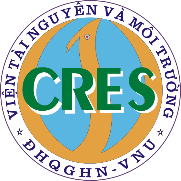On August 23rd, 2019, Director General Luu The Anh led a group of VNU-CRES scientists to conduct an inspection of 15-hectare planted forests under the program of Afforestation at Ba Vi National Park sponsored by AEON Environmental Foundation (Japan). With the support from the Board of Directors of Ba Vi National Park, VNU-CRES has planted 35 hectares of indigenous species within the area of National Park since 2014. This inspection area was planted in 2016, located at Lot 7a Sub-Area 6 of the Ba Vi National Park Rehabilitation Subdivision, in Muong Chau hamlet, Van Hoa commune, Ba Vi district, Hanoi. The main indigenous species, planted with high biodiversity values, include Calocedrus macrolepis, Parashorea chinensis, Sterculia alata, Quercus, Aglaia perviridis, Manglietia glauca, Chukrasia taburaris, Erythrophloeum fordii, Saraca dives.
During the meeting, leaders of VNU-CRES and Ba Vi National Park recognized and highly appreciated the achievements of the Program, which must be mentioned the suitable selection of indigenous species to ecological conditions for the purpose of restoring poor forest status and land after swidden agriculture. After 4 years of planting and tending, the survival rate of plants reaches up to 95% with constant growth. In an area of 15-hectare planted forests in 2016, the trees all reached an average height of 3 – 4 meters, especially some trees reached a height of 6 – 7 meters such as Aglaia perviridis or Chukrasia taburaris.
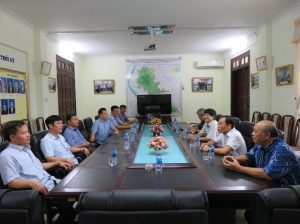 |
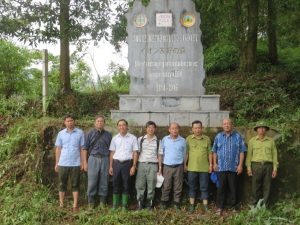 |
Lãnh đạo VNU-CRES và VQG Ba Vì thảo luận và đánh giá kết quả Dự án (ảnh trái) và Bảng lưu niệm ghi nhớ sự hợp tác giữa VNU-CRES, VQG Ba Vì và Quỹ Môi trường AEON (ảnh phải)
 |
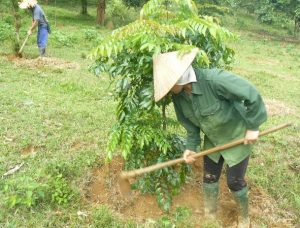 |
Hoạt động làm cỏ, vun gốc và bón phân bổ sung cho rừng trồng hàng năm
Principles and requirements for reforestation techniques, including quality of seedlings, planting techniques and forest tending techniques have strictly complied with the Project on indigenous trees. Forest planting and tending activities are closely monitored and evaluated by the Project Management Board. In particular, the requirement of average planting density from 400-600 trees / ha depending on the forest tree species. It is expected that planted forests will create high biodiversity values like primary forests in the next 30-40 years.
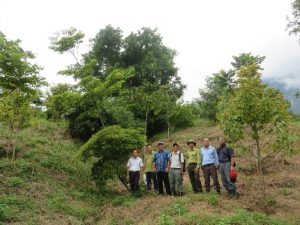 |
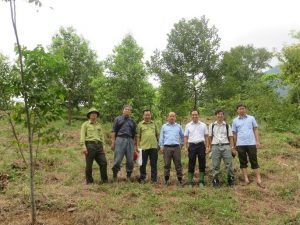 |
Cây rừng trồng năm 2016 sinh trưởng và phát triển khỏe mạnh, chiều cao trung bình đạt 4 – 5 mét, một số cây cao tới 6 – 7 mét và chuẩn bị khép tán.
 |
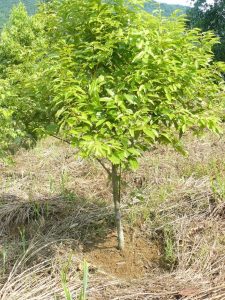 |
Làm cỏ, vun gốc và bón phân bổ sung cho rừng trồng năm 2016
 |
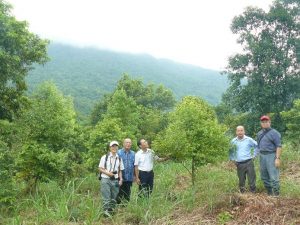 |
Tàn dư thực vật (cỏ và cây dại) được tận dụng tủ gốc cây và phủ bề mặt đất nhằm giữ ẩm và hạn chế xói mòn đất

Chốt bảo vệ rừng của VQG Ba Vì
As such, checking on the care of indigenous tree planting mentioned above is an annual activity of the VNU Central Institute for Natural Resources and Environmental Studies in the sequence of project activities. The objective of the Project is to restore forest ecosystems and biodiversity in the Ba Vi National Park Rehabilitation Zone, focusing on three main activities: (1) Planting 35 ha of forest with native tree species geography on poor forest areas and upland fields in the ecological restoration section of Ba Vi National Park; (2). Organizing the launching ceremony of afforestation with the participation of cadres and students of Vietnam National University, Hanoi, Ba Vi National Park and Japanese enterprises working in Vietnam; (3) Supporting activities such as organizing environmental education for students in high schools and supporting the development of medicinal herbs gardens in the buffer zone of Ba Vi National Park.
Afforestation is organized for 3 consecutive years from 2014 to 2016, accompanied by the next 3 years for forest protection and care. The annual launching ceremony usually attracts over 500 volunteers to participate in afforestation, including about 250 officials from Japanese enterprises, 250 officials, lecturers and students of Hanoi National University, officials of Ba Vi National Park and students from surrounding communes
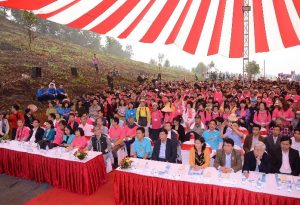 |
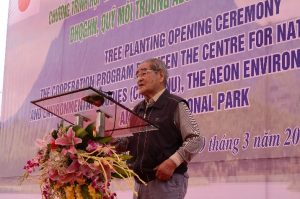 |
Quang cảnh buổi lễ trồng rừng và phát biểu của Ngài Takuya Okada, Chủ tịch Quỹ Môi trường AEON tại buổi lễ phát động trồng rừng năm 2015
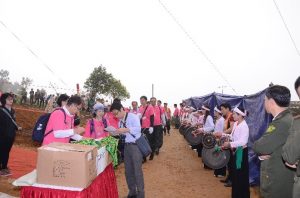 |
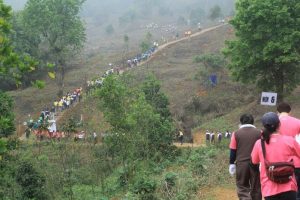 |
Các tình nguyện viên được đội cồng chiêng dân tộc bản địa đón chào và toàn cảnh lễ hội trồng rừng
 |
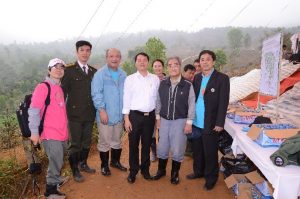 |
Lãnh đạo của Quỹ, CRES và VQG Ba Vì tham gia hoạt động trồng rừng
The project has an important role and practical significance in improving the quality of forest ecosystems by indigenous tree species suitable to the site conditions of Ba Vi National Park. The project has attracted the participation and positive response of Vietnam National University, Hanoi, Japanese businesses and students of high schools around Ba Vi National Park to participate in planting trees as well as local people’s participation in crop care, thereby raising awareness of environmental protection for the community.
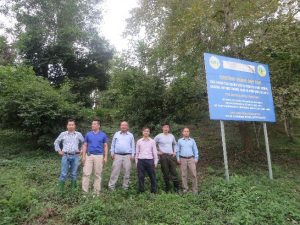 |
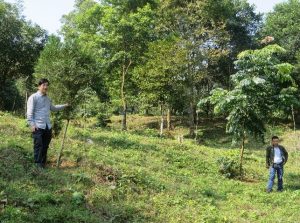 |
Diện tích cây rừng được trồng năm 2014 và 2015 đã khép tán và ngày càng xanh tốt.
The donor (AEON Environmental Foundation) highly appreciated the achieved results of the project in the following aspects: (i) Successfully restoring 35 ha of forests on shifting fields with multi-valued indigenous tree species; (ii) Raise awareness of local people and create positive spillover in the community; (iii) Improve the livelihoods of people in the buffer zone by upgrading and developing traditional medicine gardens, thereby contributing to reducing the pressure on biodiversity exploitation of Ba Vi National Park.
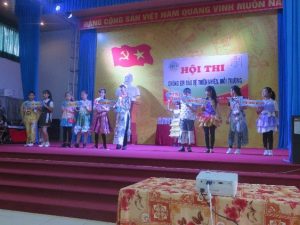 |
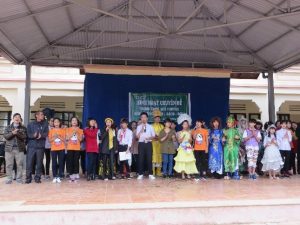 |
Các hoạt động giáo dục môi trường được thực hiện trong trường phổ thông dưới sự hướng dẫn cán bộ CRES và hỗ trợ tài chính của Dự án
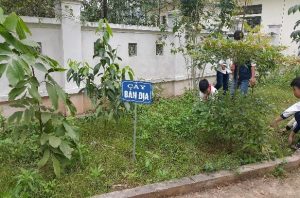 |
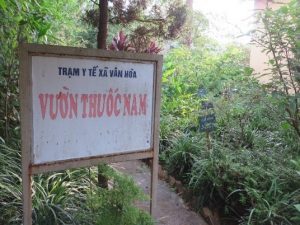 |
Xây dựng Vườn thực vật trong trường phổ thông và Vườn cây thuốc nam cho các trạm y tế của xã.
The successful outcome of the Project is a biodiversity restoration model on poor forested areas and upland fields in Ba Vi National Park by reforesting indigenous species with high biological and economic values. The effectiveness of this Project also contributes to promoting the friendship between Vietnam and Japan. At the same time, this is also a traditional model of cooperation between VNU-CRES and others Environmental foundations of the Japan’s leading economic corporations in biodiversity conservation and environmental protection in Vietnam.
